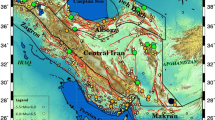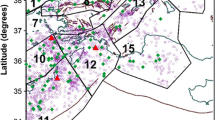Abstract
This study attempts to estimate the short-term probabilities of large earthquakes in an offshore area of northeast Japan, where long-term probabilities are assessed based on earthquake intervals. Previous studies report foreshock activity in the area, which could be used for the estimation. From this point of view, a hazard function was constructed based on the concept of “potential foreshocks” of the study area. A total of 14 earthquakes that occurred between 1976 and 2000 are employed in an assessment of models. The probability of a target earthquake occurring at a point in the time-space domain depends on the number of small earthquakes in the vicinity of the point. The parameters for defining potential foreshocks are magnitude, spatial extent, and lead-time to the point, which is optimized by a maximum probability procedure. The most effective hazard function is achieved based on foreshocks of magnitude 4.5 and larger within 1 day and 20 km. A maximum probability gain of more than 20,000 is obtained if there are two or more foreshocks. We started verification tests applying the model to data from January 1, 2001 to date, but conclusive results were not yet obtained due to the small sample size of target events.
Similar content being viewed by others
References
Aki, K., A probabilistic synthesis of precursory phenomena, in Earthquake Prediction, edited by D. W. Simpson and P. G. Richards, pp. 566–574, AGU, 1981.
Aoki, K., A. Yamazaki, Y. Yoshida, Y. Ishikawa, M. Abe, S. Masaka, and H. Takeuchi, Seismicity off Tokai observed by ocean bottom seismographs—Relation of the JMA cataloue and a result of the 2003 observation—, Programme and Abstracts, SSJ 2003 Fall Meeting, A053, 2003 (in Japanese).
Console, R. and M. Murru, A simple and testable model for earthquake clustering, J. Geophys. Res., 106, 8699–8711, 2001.
Earthquake Research Committee, the Headquarters for Earthquake Research Promotion, Government of Japan, Long-term evaluation of earthquakes in the sea off Miyagi Prefecture, 2000 (as of July 1, 2003, in Japanese).
Earthquake Research Committee, the Headquarters for Earthquake Research Promotion, Government of Japan, Long-term evaluation of earthquakes in the sea off from Sanriku to Boso, 2002 (as of July 1, 2003, in Japanese).
Evison, F. F. and D. A. Rhoades, The precursory earthquake swarm in New Zealand: Hypothesis test II, N. Z. J. Geol. Geophys., 40, 537–547, 1997.
Imoto, M., Application of the stress release model to the Nankai earthquake sequence, southwest Japan, Tectonophysics, 338, 287–295, 2001.
Imoto, M., Use of potential foreshocks to amplify short term probabilities of recurrent large earthquakes along the Japan trench, Zisin II, 56, 2003 (in Japanese).
Maeda, K., The use of foreshocks in probabilistic prediction along the Japan and Kuril trenches, Bull. Seism. Soc. Am., 86, 242–254, 1996.
Matthews, M. V., W. L. Ellsworth, and P. A. Reasenberg, A Brownian Model for Recurrent Earthquakes, Bull. Seism. Soc. Am., 92, 2233–2250, 2002.
Meteorological Research Institute, Forecast of earthquakes far off Sanriku Coast, July, 1992—Probability Estimation of Earthquake Occurrence from the Viewpoint of Successiveness of Seismic Activity—, Report of the Coordinating Committee for Earthquake Prediction, 49, 60–66, 1993 (in Japanese).
Mogi, K., Some discussions on aftershocks, foreshocks and earthquake swarms—the fracture of a semi-infinite body caused by an inner stress origin and its relation to the earthquake phenomena (third paper), Bull. Earthq. Res. Inst., 41, 615–658, 1963.
Ogata, Y, Statistical discrimination of foreshocks from other earthquake clusters, Geophys. J. Int., 127, 17–30, 1996.
Rhoades, D. A. and F. F. Evison, On the reliability of precursors, Phys. Earth Planet. Inter., 58, 137–140, 1989.
Sakamoto, Y., M. Ishiguro, and G. Kitagawa, Akaike Information Criterion Statistics, D. Reidel, Dordrecht, 290 pp, 1983.
Schwartz, D. P. and K. J. Coppersmith, Fault behavior and characteristic earthquakes: Examples from the Wasatch and San Andreas fault zones, J. Geophys. Res., 89, 5681–5698, 1984.
Utsu, T., Probalities in earthquake prediction, Zisin II, 30, 179–185, 1977 (in Japanese).
Utsu, T., Probabilities in earthquake prediction (the second paper), Bull. Earthq. Res. Inst., 57, 499–524, 1982 (in Japanese).
Utsu, T., Estimation of parameters for recurrence models of earthquakes, Bull. Earthq. Res. Inst., 59, 53–66, 1984.
Author information
Authors and Affiliations
Corresponding author
Rights and permissions
About this article
Cite this article
Imoto, M. Enhancement of the short-term probability of large earthquakes with a foreshock model and verification test. Earth Planet Sp 56, 741–748 (2004). https://doi.org/10.1186/BF03353082
Received:
Revised:
Accepted:
Published:
Issue Date:
DOI: https://doi.org/10.1186/BF03353082




